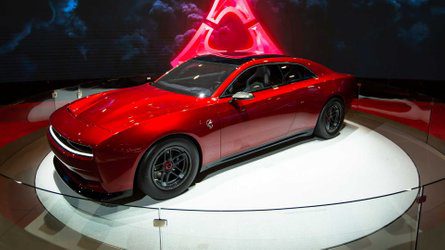Faking It: 2025 Dodge Charger EV To Simulate Vibrating ‘Engine’
Software seems to be opening up endless possibilities in EVs. As if features like pumping artificial sounds through speakers, simulating manual gear shifts, and creating music through pedals weren’t innovative enough, automakers are now going one step further to ensure that some of you ICE car lovers don’t suffer from FOMO in the electric future.
And that step involves making EVs, erm, vibrate.
The upcoming 2025 Dodge Charger EV, which in concept form broke cover as the Dodge Charger Daytona SRT Concept last year, will not only pump fake noises through its gimmicky-sounding “Fratzonic Chambered Exhaust,” but also incorporate a feature called “Active Vibration Enhancement,” according to a patent filing by Dodge’s parent company Stellantis with the World Intellectual Property Organization.
Get Fully Charged
American muscle cars are going electric.
Muscle cars are unlikely to be left behind as all car segments in the U.S. turn to battery power. But to make them as exciting as before, at least in the traditional sense, carmakers are using software to introduce artificial sounds and vibrations.
It’s hard to believe that the engineers would be able to replicate the vibrations of the Dodge Charger Hellcat SRT’s monstrous fuel-gulping V8. But Dodge could be onto something innovative here. The AVE will generate vibrations tailored to specific real-world vehicle conditions, such as idle, driving, or shifting gears, with help from a bunch of sensors and “force generators” installed throughout the vehicle body and chassis.
Essentially, the sensors would monitor vehicle conditions, and then signal the force generators to create vibrations mimicking those of an internal combustion engine. A controller would manage this process. In principle, at least, it seems similar to the haptic feedback on smartphones or gaming consoles.




The pre-production version of the upcoming 2025 Dodge Charger EV looks quite true to the concept.
By providing matching sound and vibration cues, Dodge thinks driver awareness and pedestrian safety can be improved. The AVE would synchronize with the also-in-development Active Sound Enhancement (ASE) feature to let the driver know if the EV is switched on or off, thanks to audible and tactile feedback.
EVs that are completely silent risk causing “unintended movements,” the patent application said. Moreover, customizable alerts would enable vibration profiles for lane departure warnings and driver notifications, potentially improving safety.
That said, Dodge isn’t the only brand looking into incorporating artificial vibrations into its future cars. Last year, BMW was also reportedly considering vibration feedback for the gearbox of its future M-performance EVs.
One could argue that the vibration-free experience in EVs leads to a smooth and stress-free driving experience, and is one of the many advantages EVs have. However, it’s also true that vibrations in a gas car can be critical safety indicators. They alert drivers about potential issues with the engine, tires, or loose components.
Sudden or unusual vibrations may signal the need for immediate attention to prevent accidents or mechanical failures. How Dodge’s “vibroacoustic system” fares on that front would be worth watching out for.







